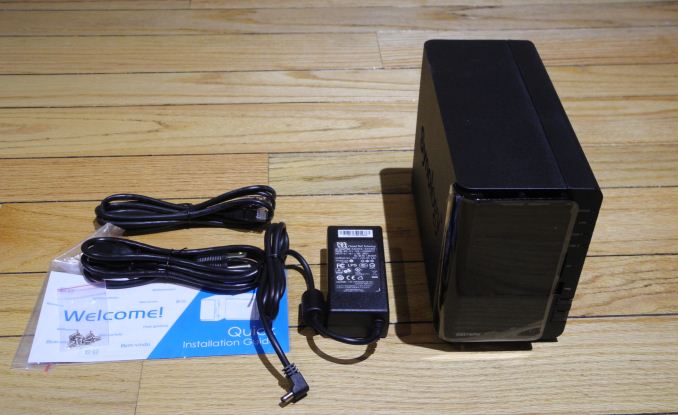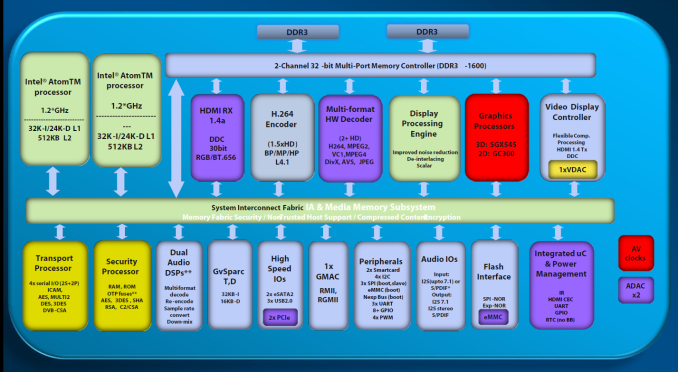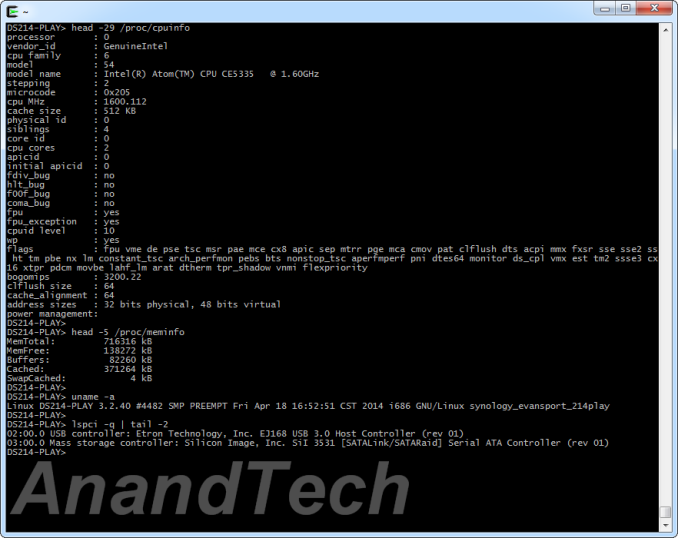Synology DS214play: Intel Evansport Almost Done Right
by Ganesh T S on May 20, 2014 3:00 PM ESTHardware Aspects & Usage Impressions
The industrial design of Synology's 2-bay NAS units hasn't really changed since we last reviewed one in the DS211+. We continue to have the detachable face-plate (a fingerprint magnet) and hot-swap bays (with the hard drives kept in place on the caddies with screws on the side). The contents of the DS214play package are as below:
- Synology DS214play chassis
- 2M Cat 5E Ethernet cable
- 65 W external power supply with US power cord
- Getting Started guide
- Screws for hard disk installation
In terms of external I/O, we have a SD card slot and a USB 2.0 port in the front panel. On the rear, we have two USB 3.0 slots, an eSATA port and a single RJ-45 GbE port. The eSATA port can be used to attach a DX513 5-bay expansion module to provide a total of 7 bays. An important aspect to remember is that the hard drives in the expansion module can't be used for volume expansion, but additional volumes only.
Platform Analysis
The block diagram below gives the layout of the Intel CE5335 SoC. Typically, x86 NAS units come with dual network ports (capable of port trunking), but units based on Evansport (such as the DS214play) don't have that because of the lack of support in the platform. This is acceptable, considering that the unit is supposed to cater to home consumers who want to use it as a media server.
The other important aspect is the available high-speed I/Os. In a NAS platform based on the CE5335, there are two SATA ports and two PCIe 2.0 lanes. There is no native USB 3.0 support in the SoC. Therefore, the DS214play's USB 3.0 support definitely from a USB 3.0 to PCIe bridge. Since the two SATA ports are already being used for the drive bays, it can be inferred that the eSATA port is enabled using a PCIe to SATA bridge. Considering these inferences, it looks like the platform should be able to support all peripherals at full speed (except for the two USB 3.0 ports which talk to the SoC through a single PCIe lane). One option to determine the components on the board would have been disassembling the unit. Fortunately, Synology provides SSH access. The screenshot below exposes some of the hardware aspects of the DS214play.
As expected, the USB 3.0 ports are enabled by the Etron EJ168A USB 3.0 to PCIe bridge, while the eSATA port is enabled by the Silicon Image SiI 3531 SATA to PCIe bridge. TechPowerUp also has a great teardown of the NAS in their review, where they show these components on the board (in addition to the Realtek RTL8211E GMAC for the GbE port and the Genesys Logic GL836 SDIO to USB 2.0 bridge for the SD card slot). A look back at the CE5335 block diagram shows that we have three USB 2.0 ports in the SoC. Only two get used, one for the SD card slot and the other for the front USB 2.0 port.
Setup & Usage
After connection to the network, the unit obtains a DHCP address (even in diskless mode) and could be setup using the web UI at http://<DS214play-IP>. The setup process is straightforward. At least one of the bays needs to be populated. We chose to use the Synology Assistant tool to initialize the NAS (we have used the web interface before in our previous Synology reviews). The firmware (Synology Disk Station Manager - DSM) can be uploaded from a local file in this process. Basic network settings (DHCP / manual static IP) can also be set up using the tool. After a restart, the rest of the configuration is handled through the web interface.
Upon logging into a freshly installed DSM, the user is provided with various options to aid in setup of external access to the NAS. Synology allows its users to create a MyDS account on their servers. The NAS units themselves are provided with a unique 'QuickConnect' ID. A MyDS account can have multiple QuickConnect IDs associated with it. The combination of this ID and a MyDS account helps Synology operate a relay service for access to the NAS from an external network. Users can opt to not register for these, but still enjoy external access if they forward the appropriate ports on their router. We will cover more on this in a later section.
DSM 5.x, in keeping up with the previous versions, is undoubtedly the gold standard to which all other NAS interfaces must measure up to. The combination of a desktop-style interface and a multi-tasking UI with support for desktop widgets make it a pleasure to use. Backing up the eye-candy is a rock-solid Linux-based storage management system and a wealth of applications (both Synology-created and third-party developed). Exploring all the features of DSM 5.x deserves a separate piece by itself. However, we will take a slightly different approach. In one of the later sections, we will look in detail into the external access and multimedia features of DSM 5.x (an area where the DS214play is supposed to excel). We have some more Synology reviews in the pipeline and those will be used to look at the other features.
Our testing sequence started with the insertion of a single disk and configuring it in Synology Hybrid RAID (SHR). For a single disk, it is effectively a JBOD configuration, but the addition of a second disk triggers a migration to RAID-1. While migrating to the new RAID level on the DS214play, the data remained online (as expected) and the process got done without any hitch. We tested RAID-1 rebuild by yanking out a disk during operation and re-inserting it. The rebuild process was also uneventful. On the whole, we were very satisfied with the unit's handling of storage operations (including handling of disk failures).





































45 Comments
View All Comments
toonvl - Tuesday, May 20, 2014 - link
For me it's hardware RAID and RAID expansion options. FreeNAS OS can help you build a custom NAS yourself, but cannot provide RAID expansion sadly enough.That's if you want RAID 5, 6 and the likes and have the option to add/exchange disks with different capacity etc.. But if you just want RAID 1 and stick to it, then you're probably better off with a micro-ATX rig and software RAID like you suggest.ZeDestructor - Tuesday, May 20, 2014 - link
All in all, I have been completely sold on ZFS, and have no plans to use anything else for a NAS or any other form of critical storage until btrfs (a GPL-compliant and even more powerful successor to ZFS) gets a stable release. Oh, and personally I wouldn't run FreeNAS: I'd run bare FreeBSD and set it up manually.PS: A nice article from arstechnica on ZFS (and CoW FS in general): http://arstechnica.com/information-technology/2014...
ZeDestructor - Tuesday, May 20, 2014 - link
Gah... most of my comment about ZFS got nuked.... And I can't be bothered to retype in all out, so here's the tl;dr edition (read the arstechnica article I linked for more detailed info):Compared to HW RAID controllers:
- RAID5/6: ZFS has RAIDZ1/2/3, for 1, 2 or 3 disks worth of redundancy, equivalent to RAID5/6/there is no equivalent to RAIDZ3 to my knowledge
- Add/exchange disks with different capacity: Done in ZFS by swapping each disk in a vdev (ZFS term more or less equivalent to arrays), then "resilvering" once all is done to increase it's size.
Features no HW RAID controller has (to my knowledge):
- Copy-on-Write (CoW): each update to a file is written as the difference to the original file. This allows for self-healing (damaged blocks are recovered using checksums and old data to regenerate current data) and snapshots (snapshots of the FS is a a state a a point in time). Snapshots make incremental backups trivial. In fact, quite a lot of people use snapshots to back up production databases instead of doing a traditional dump the DB to disk method.
All in all, I have been completely sold on ZFS, and have no plans to use anything else for a NAS or any other form of critical storage until btrfs (a GPL-compliant and even more powerful successor to ZFS) gets a stable release. Oh, and personally I wouldn't run FreeNAS: I'd run bare FreeBSD and set it up manually.
PS: A nice article from arstechnica on ZFS (and CoW FS in general): http://arstechnica.com/information-technology/2014...
toonvl - Wednesday, May 21, 2014 - link
thanks! I'll check this out. When I have a need for a next expansion I'm probably going to use this :)JeffS - Tuesday, May 20, 2014 - link
I've been using 2-drive NAS appliances (first Netgear and then Synology) for probably 6 or 7 years now. I've got above-average technical acumen, but with two little kids and a busy job, I don't have enough hours in the day right now to worry about reliable storage. These things are small enough to sit on a bookshelf, they run quietly with low power, and a red light starts flashing and a buzzer sounds when there's a problem. About a year ago, one of the drives in my RAID-1 died. I swapped in a spare and never missed a beat. It would have been divorce court for me if our 20,000 family photos went down the drain. Yes, I still run regular backups (again, one push of a button on the front panel with an external drive plugged in), but it's a huge relief knowing that the odds are low of drive failure taking down our storage system. I never get support calls from home asking why the storage system is offline.Having said all that, I just bought a $250 Dell mini tower server, and I plan to move to it as our storage array. I'll probably keep the Synology and set up automated backup. I'm now trying to find space in the wiring closet for the Dell, and it's not an 'appliance' like these NAS units are.
Basically, the NAS took away all of the thinking with regard to redundant, networked storage, and that allowed me to stop procrastinating and get everything centralized with RAID and backup. I've got a lot of hobbies, but our primary storage array shouldn't be one of them.
We do only need about 2 TB of storage, so we're probably the ideal customer for a unit like this.
bill.rookard - Tuesday, May 20, 2014 - link
Couldn't agree more. I picked up a very nice rackable case a while back, dropped a Gigabyte mATX board in with a dual core Phenom processor, a few GB of ram, and 5 WD drives with FreeNAS. With the exception of one RMA'd drive which failed after about 6 months, it's been absolutely rock solid for about 7 years now. Total cost on the entire build, including drives (5 x 2TB drives) was right around $800 (the drives alone were $600 at the time).While I certainly do appreciate having an easy setup for this type of unit (plug, configure, play), the limitations are just too restrictive (ie: either 4TB with redundancy or 8TB without - which is simply NOT a real choice). Yes, I'm certainly an edge case when it comes to this type of thing, but looking at any 5-bay devices (which would be my personal minimum), you're easily into near four digit costs and that's NOT including a drive.
ganeshts - Tuesday, May 20, 2014 - link
I used to think like you guys till very recently. However, in addition to some of the points mentioned by other readers, there are certain aspects that only these NAS vendors provide:1. Mobile app ecosystem - Creation of a mobile app (iOS / Android) which presents an easy and intuitive interface to your NAS's contents
2. Operation of relay service to access your NAS content from an external network without port forwarding
3. Automatic backup of data from mobile devices to the NAS
4. In the case of DS214play, a hardware accelerated transcode engine behind the media server feature.
For a non-tech savvy consumer, or even for a person who knows the internal details, but doesn't want to spend time configuring or building a NAS, the units supplied by these NAS vendors make a good choice.
ZeDestructor - Tuesday, May 20, 2014 - link
I'll consider buying them when they use Copy-on-Write filesystems, and come in sizes greater than 16bays for under 6k (a fully-built backblaze pod for 45 drives comes in around the 3k mark). I value data integrity more than any convenience, and as of now (to my knowledge), a CoW FS is the best thing you can get.If you are in contact with said companies, it would be nice if you could mention that to them... anyone who has encountered bit rot knows that RAID just isn't enough these days...
jamyryals - Tuesday, May 20, 2014 - link
Couldn't agree with you more Ganesh. I have a home built set up right now on an old tower. I've been running Plex/Cloud-backups for a while now, and the fact these standalone NAS boxes have native integration with little hassle is very attractive. In the future I will be buying a solution like this.Aikouka - Tuesday, May 20, 2014 - link
Does Plex (read: Plex's modified version of FFMPEG) work with Evansport yet? Last I checked a month or so ago, it doesn't, which means you do not get hardware transcoding with this device (or any other Evansport-based NAS).